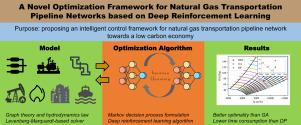A novel optimization framework for natural gas transportation pipeline networks based on deep reinforcement learning
IF 9.6
Q1 COMPUTER SCIENCE, ARTIFICIAL INTELLIGENCE
引用次数: 0
Abstract
Natural gas is an emerging and reliable energy source in transition to a low-carbon economy. The natural gas transportation pipeline network systems are crucial when transporting natural gas from the production endpoints to processing or consuming endpoints. Optimizing the operational efficiency of compressor stations within pipeline networks is an effective way to reduce energy consumption and carbon emissions during transportation. This paper proposes an optimization framework for natural gas transportation pipeline networks based on deep reinforcement learning (DRL). The mathematical simulation model is derived from mass balance, hydrodynamics principles of gas flow, and compressor characteristics. The optimization control problem in steady state is formulated into a one-step Markov decision process (MDP) and solved by DRL. The decision variables are selected as the discharge ratio of each compressor. By the comprehensive comparison with dynamic programming (DP) and genetic algorithm (GA) in three typical element topologies (a linear topology with gun-barrel structure, a linear topology with branch structure, and a tree topology), the proposed method can obtain 4.60% lower power consumption than GA, and the time consumption is reduced by 97.5% compared with DP. The proposed framework could be further utilized for future large-scale network optimization practices.

基于深度强化学习的天然气运输管道网络新型优化框架
在向低碳经济转型的过程中,天然气是一种新兴的可靠能源。将天然气从生产终端输送到加工或消费终端,天然气运输管网系统至关重要。优化管网中压缩机站的运行效率是减少运输过程中能源消耗和碳排放的有效途径。本文提出了一种基于深度强化学习(DRL)的天然气运输管网优化框架。数学模拟模型源于质量平衡、气体流动的流体力学原理和压缩机特性。稳态优化控制问题被表述为一步马尔可夫决策过程(MDP),并通过 DRL 进行求解。决策变量选择为每台压缩机的排气比。通过与动态编程(DP)和遗传算法(GA)在三种典型元件拓扑结构(炮筒结构线性拓扑、分支结构线性拓扑和树形拓扑)中的综合比较,所提出的方法比 GA 的功耗低 4.60%,比 DP 的时间消耗减少 97.5%。提出的框架可进一步用于未来的大规模网络优化实践。
本文章由计算机程序翻译,如有差异,请以英文原文为准。
求助全文
约1分钟内获得全文
求助全文
来源期刊

Energy and AI
Engineering-Engineering (miscellaneous)
CiteScore
16.50
自引率
0.00%
发文量
64
审稿时长
56 days
 求助内容:
求助内容: 应助结果提醒方式:
应助结果提醒方式:


